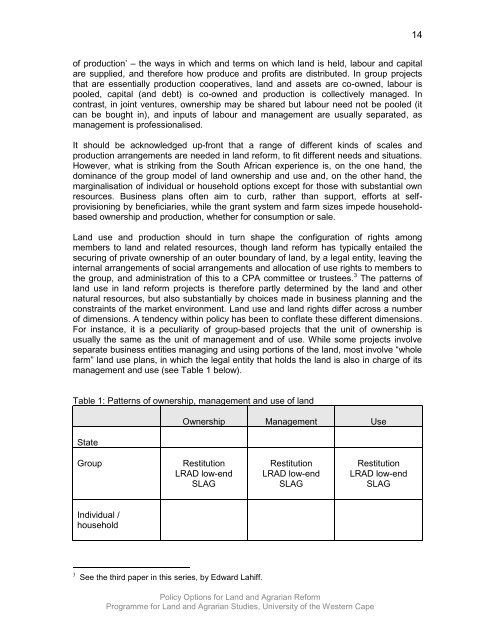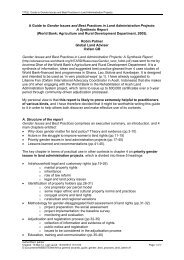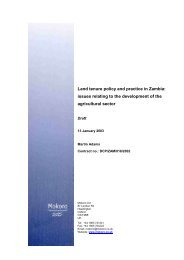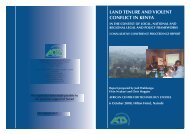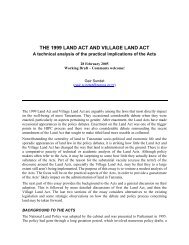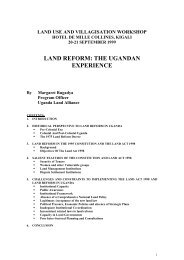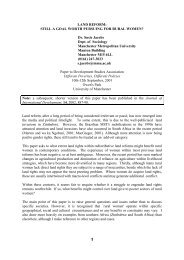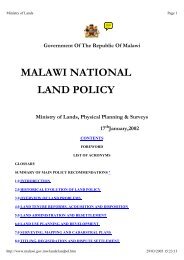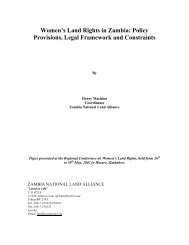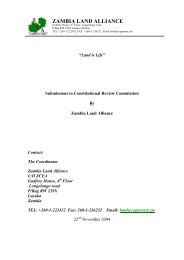14of production’ – the ways in which and terms on which land is held, labour and capitalare supplied, and therefore how produce and profits are distributed. In group projectsthat are essentially production cooperatives, land and assets are co-owned, labour ispooled, capital (and debt) is co-owned and production is collectively managed. Incontrast, in joint ventures, ownership may be shared but labour need not be pooled (itcan be bought in), and inputs of labour and management are usually separated, asmanagement is professionalised.It should be acknowledged up-front that a range of different kinds of scales andproduction arrangements are needed in land reform, to fit different needs and situations.However, what is striking from the South African experience is, on the one hand, thedominance of the group model of land ownership and use and, on the other hand, themarginalisation of individual or household options except for those with substantial ownresources. Business plans often aim to curb, rather than support, efforts at selfprovisioningby beneficiaries, while the grant system and farm sizes impede householdbasedownership and production, whether for consumption or sale.Land use and production should in turn shape the configuration of rights amongmembers to land and related resources, though land reform has typically entailed thesecuring of private ownership of an outer boundary of land, by a legal entity, leaving theinternal arrangements of social arrangements and allocation of use rights to members tothe group, and administration of this to a CPA committee or trustees. 3 The patterns ofland use in land reform projects is therefore partly determined by the land and othernatural resources, but also substantially by choices made in business planning and theconstraints of the market environment. Land use and land rights differ across a numberof dimensions. A tendency within policy has been to conflate these different dimensions.For instance, it is a peculiarity of group-based projects that the unit of ownership isusually the same as the unit of management and of use. While some projects involveseparate business entities managing and using portions of the land, most involve “wholefarm” land use plans, in which the legal entity that holds the land is also in charge of itsmanagement and use (see Table 1 below).Table 1: Patterns of ownership, management and use of landStateOwnership Management UseGroupRestitutionLRAD low-endSLAGRestitutionLRAD low-endSLAGRestitutionLRAD low-endSLAGIndividual /household3 See the third paper in this series, by Edward Lahiff.Policy Options for Land and Agrarian ReformProgramme for Land and Agrarian Studies, University of the Western Cape
15In contrast, the option of state or individual-level control has been marginalised. It is onlyin relatively few projects, usually where higher LRAD grants are accessed, thatindividuals or households own, manage and use land. Because land reform has beenfocused on transfer of private land ownership, it is only in the context of municipalcommonage that the state plays a role in ownership and management of land (see Table2 below). An advantage of this model is the provision of a public good on secure termsto poor land users, and a continuing public function in the maintenance of infrastructure– especially water points and fencing (Anderson and Pienaar 2003).Table 2: Patterns of ownership, management and use of landOwnership Management UseState Commonage CommonageGroup Commonage CommonageIndividual /householdLRAD high-end LRAD high-end CommonageLRAD high-endSettlement is a central component of land uses, particularly in restitution claims withmany members, and in existing redistribution projects where there are many membersdue to the grant system. In both, the imperative is to provide housing on the transferredland. The question of settlement has been addressed in three ways. Usually it has beena single closer settlement, which should in theory at least allow provision ofinfrastructure for the delivery of services like water and sanitation, as part of the projectplan. (At Algeria in the Cedarberg, for instance, this was taken a further step, with theestablishment of a small township). Less common has been in the form of a dispersedsettlement pattern, without public provision of infrastructure and services. However, athird response to resolving this tension between settlement and agricultural uses of landhas been to avoid settlement altogether by prohibiting people from moving onto theirland. Quite illogically, this has been seen in community claims in Limpopo, where theprovincial Department of Agriculture has instructed members not to move onto their land– necessitating costly commuting from their places of residence (Wegerif 2004). Dikgoloproject is an example where this insistence that new land owners not live on their landresulted in people having to commute to and from it, from their homes in communalareas (PLAAS 2007). The question of settlement – or rather, non-settlement – onredistributed land has underpinned strategic partnership arrangements, wherecommercial production on the land remains intact and where the new owners do notfarm the land themselves, but are shareholders in operating companies and, for thelucky few, may become employees (Derman et al 2006). Such partnerships have not, todate, made provision for the owners of the land to be able to settle on the land or to useany of it for their own purposes, alongside the commercial enterprise.Land reform projects, then, typically emphasise whole-farm commercial enterprises,many of which are costly, complex, take time to deliver benefits, are often high-risk andseldom allow for multiple uses of farmland other than those undertaken by thePolicy Options for Land and Agrarian ReformProgramme for Land and Agrarian Studies, University of the Western Cape


